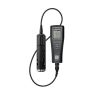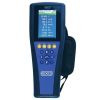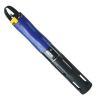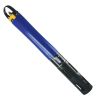ProDSS Water Quality Meter Rental
Features
- Measure 9 parameters in a compact platform
- Integrated GPS for geo-referenced measurements
- Includes 410mL groundwater flow cell
- Expedited repair and warranty service
- Lifetime technical support
- More
Simultaneously measure and log temperature, conductivity, salinity, TDS, resistivity, dissolved oxygen (optical), pH, ORP, and turbidity.
- (1) ProDSS multi-parameter display with GPS
- (1) ProDSS 4-port cable assembly, 4m
- (1) Temperature/conductivity sensor
- (1) Optical dissolved oxygen sensor
- (1) pH/ORP sensor
- (1) Optical turbidity sensor
- (1) Flow cell
- (1) USB cable for charging & PC connection
- (1) Universal AC charger
- (1) Maintenance kit
- (1) Calibration report
- (1) USB drive with KorDSS software
- (1) Hard-sided carrying case
- YSI ProDSS Multi-Parameter Water Quality Meter Overview
- YSI ProDSS Multi-Parameter Water Quality Meter Specifications
- YSI ProDSS Multi-Parameter Water Quality Meter Catalog
- YSI ProDSS Multi-Parameter Water Quality Meter Quick Start Guide
- YSI ProDSS Multi-Parameter Water Quality Meter Manual
- YSI ProDSS Multi-Parameter Water Quality Meter Calibration Worksheet
In The News
Lake Erie Volunteer Science Network: Building Trust in Citizen Science Programs
Citizen science programs have popped up across the United States, focusing on connecting local communities with nearby water resources and building a trustworthy data pool over the sampling period. While commonly utilized as a means of ensuring that large watersheds or lake regions are adequately sampled, the credibility and success of such programs have been called into question. [caption id="attachment_38996" align="alignnone" width="940"] HRWC volunteers measure stream velocity across a subsection of Woods Creek, a tributary of the Huron River near Belleville, Michigan. Stream velocity measurements can be combined with water level measurements to calculate stream flow and chemical parameter loads.
Read MoreYSI ProDSS Multi-Parameter Water Quality Meter Review
There's no shortage of options when it comes to water quality monitoring equipment. If you're looking for an all-in-one multi-parameter sampling meter, then the YSI ProDSS is a prime choice. Along with its field-rugged construction, backlit display, rechargeable battery, a wide selection of cable lengths and a long list of measurement parameters, the meter offers the latest in smart sensor technology. Constructed of titanium and laser welded, the smart sensors offer superior performance in fresh, brackish and saltwater applications. Upon connection, the smart sensors are automatically displayed on the meter. With internally stored calibration constants, any sensor can plug into any port and provide accurate data in just seconds.
Read MoreFrom Assessment to Angler: Continual Research Ensures Lake Erie Remains a Beacon of Freshwater Fishing
Lake Erie is well known for its abundant recreational fishing. Anglers come from across the country to try their luck at the “walleye capital of the world” and search for other freshwater species, such as bass, perch, and steelhead trout. As one of the world’s largest freshwater fisheries, much effort is made behind the scenes to maintain fishing opportunities for visitors to enjoy year after year, efforts that often go unnoticed by the public. One of the lake's most important economic and tourism centers is the city of Sandusky, home to the Sandusky Fisheries Research Station . As part of the Ohio Division of Wildlife, the unit serves as a base for assessing fish populations and managing harvest with partner agencies from around Lake Erie.
Read More
























